Quantitative Analysis of Yield Stress and Its Evolution in Fiber-Reinforced Cemented Paste Backfill
Abstract
1. Introduction
2. Methodology
3. Materials and Experimental Methods
3.1. Raw Materials and Sample Preparation
3.2. Experimental Methods
3.2.1. Stress Ramp-Up Test
3.2.2. Yield Stress Test
4. Results and Discussion
4.1. Maximum Packing Fraction
4.2. Yield Stress
Model Validation
4.3. Time-Dependent Yield Stress
5. Conclusions
- The proposed rheology-based method effectively captures the dynamic characteristics of PP fibers in CPB during the shearing process, enabling the accurate determination of the maximum packing fraction. This approach provides a reliable tool for gaining deeper insights into fiber packing behavior within CPB.
- The maximum packing fraction decreased with increasing fiber length, ranging from 0.661 for 3 mm fibers to 0.534 for 12 mm fibers, highlighting the significant influence of fiber geometry on packing efficiency. Moreover, shorter fibers demonstrate greater advantages in space filling and packing efficiency, while the inclusion of longer fibers dilutes the overall packing performance.
- The improved yield stress model demonstrated high predictive accuracy, with a correlation coefficient of 0.93 between the predicted and experimental values. Additionally, the relative yield stress was always less than the relative yield stress evolution rate due to the influence of cement hydration efficiency. By adjusting the exponential parameters in the yield stress model, the model successfully achieves an accurate description of the yield stress evolution rate.
Author Contributions
Funding
Data Availability Statement
Acknowledgments
Conflicts of Interest
References
- Zhang, C.; Taheri, A.; Du, C.; Xia, W.; Tan, Y. Mechanical Characteristics and Macro-Microscopic Response Mechanisms of Cemented Paste Backfill under Different Curing Temperatures. Minerals 2024, 14, 433. [Google Scholar] [CrossRef]
- Sagade, A.; Fall, M. Study of Fresh Properties of Cemented Paste Backfill Material with Ternary Cement Blends. Constr. Build. Mater. 2024, 411, 134287. [Google Scholar] [CrossRef]
- Wu, A.; Wang, Y.; Ruan, Z.; Xiao, B.; Wang, J.; Wang, L. Key Theory and Technology of Cemented Paste Backfill for Green Mining of Metal Mines. Green Smart Min. Eng. 2024, 1, 27–39. [Google Scholar] [CrossRef]
- Yang, L.; Jia, H.; Wu, A.; Jiao, H.; Chen, X.; Kou, Y.; Dong, M. Particle Aggregation and Breakage Kinetics in Cemented Paste Backfill. Int. J. Miner. Metall. Mater. 2024, 31, 1965–1974. [Google Scholar] [CrossRef]
- Wang, D.; Zhang, Q.; Liu, B.; Zhu, D.; Chen, Q. Enhanced Immobilization of Fluoride in Phosphogypsum-Based Cement-Free Paste Backfill Modified by Polyaluminum Chloride and Its Mechanism. Constr. Build. Mater. 2025, 458, 139622. [Google Scholar] [CrossRef]
- Zhao, X.; Wang, H.; Luo, G.; Dai, K.; Hu, Q.; Jin, J.; Liu, Y.; Liu, B.; Miao, Y.; Zhu, K.; et al. Study on the Rheological and Thixotropic Properties of Fiber-Reinforced Cemented Paste Backfill Containing Blast Furnace Slag. Minerals 2024, 14, 964. [Google Scholar] [CrossRef]
- Guner, N.U.; Yilmaz, E.; Sari, M.; Kasap, T. Cementitious Backfill with Partial Replacement of Cu-Rich Mine Tailings by Sand: Rheological, Mechanical and Microstructural Properties. Minerals 2023, 13, 437. [Google Scholar] [CrossRef]
- Carnogursky, E.A.; Fall, M.; Haruna, S. Rheology and Setting Time of Saline Cemented Paste Backfill. Miner. Eng. 2023, 202, 108258. [Google Scholar] [CrossRef]
- Cui, L.; McAdie, A. Experimental Study on Evolutive Fracture Behavior and Properties of Sulfate-Rich Fiber-Reinforced Cemented Paste Backfill under Pure Mode-I, Mode-II, and Mode-III Loadings. Int. J. Rock Mech. Min. Sci. 2023, 169, 105434. [Google Scholar] [CrossRef]
- Hou, Y.; Yang, K.; Yin, S.; Yu, X.; Kou, P.; Wang, Y. Enhancing Workability, Strength, and Microstructure of Cemented Tailings Backfill through Mineral Admixtures and Fibers. J. Build. Eng. 2024, 84, 108590. [Google Scholar] [CrossRef]
- Yang, J.; Zhao, K.; Yu, X.; Yan, Y.; He, Z.; Zhou, Y.; Lai, Y. Fracture Evolution of Fiber-Reinforced Backfill Based on Acoustic Emission Fractal Dimension and b-Value. Cem. Concr. Compos. 2022, 134, 104739. [Google Scholar] [CrossRef]
- Chakilam, S.; Cui, L. Effect of Polypropylene Fiber Content and Fiber Length on the Saturated Hydraulic Conductivity of Hydrating Cemented Paste Backfill. Constr. Build. Mater. 2020, 262, 120854. [Google Scholar] [CrossRef]
- Xue, G.; Yilmaz, E.; Song, W.; Cao, S. Fiber Length Effect on Strength Properties of Polypropylene Fiber Reinforced Cemented Tailings Backfill Specimens with Different Sizes. Constr. Build. Mater. 2020, 241, 118113. [Google Scholar] [CrossRef]
- Xu, W.; Li, Q.; Zhang, Y. Influence of Temperature on Compressive Strength, Microstructure Properties and Failure Pattern of Fiber-Reinforced Cemented Tailings Backfill. Constr. Build. Mater. 2019, 222, 776–785. [Google Scholar] [CrossRef]
- Li, X.; Cao, S.; Yilmaz, E. Microstructural Evolution and Strengthening Mechanism of Aligned Steel Fiber Cement-Based Tail Backfills Exposed to Electromagnetic Induction. Int. J. Miner. Metall. Mater. 2024, 31, 2390–2403. [Google Scholar] [CrossRef]
- Cao, S.; Che, C.; Zhang, Y.; Shan, C.; Liu, Y.; Zhao, C.; Du, S. Mechanical Properties and Damage Evolution Characteristics of Waste Tire Steel Fiber-Modified Cemented Paste Backfill. Int. J. Min. Sci. Technol. 2024, 34, 909–924. [Google Scholar] [CrossRef]
- Xue, G.; Yilmaz, E.; Song, W.; Yilmaz, E. Influence of Fiber Reinforcement on Mechanical Behavior and Microstructural Properties of Cemented Tailings Backfill. Constr. Build. Mater. 2019, 213, 275–285. [Google Scholar] [CrossRef]
- Zhao, K.; Zhao, K.; Yan, Y.; Yang, J.; Wu, J.; Lai, Y.; Liu, L.; Zeng, X. Influence of Different Fibers on Compressive Toughness and Damage of Early Age Cemented Tailings Backfill. Environ. Sci. Pollut. Res. 2023, 30, 37449–37461. [Google Scholar] [CrossRef]
- Yin, S.; Hou, Y.; Chen, X.; Zhang, M. Mechanical, Flowing and Microstructural Properties of Cemented Sulfur Tailings Backfill: Effects of Fiber Lengths and Dosage. Constr. Build. Mater. 2021, 309, 125058. [Google Scholar] [CrossRef]
- Nematollahi, M.; Ahmadi, M.S.; Fattahi, S. Mechanical Properties of Glass and Jute Fiber Reinforced Thermoplastic Composites with Waste PET Needle-Punched Carpet Matrix. World J. Eng. 2024; ahead of print. [Google Scholar]
- Cao, P.; Feng, D.; Zhou, C.; Zuo, W. Study on Fracture Behavior of Polypropylene Fiber Reinforced Concrete with Bending Beam Test and Digital Speckle Method. Comput. Concr. 2014, 14, 527–546. [Google Scholar] [CrossRef]
- Adlparvar, M.R.; Esmaeili, M.; Taghavi Parsa, M.H. Strength Properties of Fiber Reinforced Concrete Including Steel Fibers. World J. Eng. 2024, 21, 194–202. [Google Scholar] [CrossRef]
- Sathe, S.; Dandin, S.; Wagale, M.; Mali, P.R. Effective Combinations of Different Fiber Reinforcements and Super-Plasticizers for Optimal Performance of Geo-Polymer Concrete. World J. Eng. 2024; ahead of print. [Google Scholar]
- Xue, G.; Yilmaz, E.; Feng, G.; Cao, S.; Sun, L. Reinforcement Effect of Polypropylene Fiber on Dynamic Properties of Cemented Tailings Backfill under SHPB Impact Loading. Constr. Build. Mater. 2021, 279, 122417. [Google Scholar] [CrossRef]
- Pan, J.; Ping, P.; Ding, B.; Zhu, B.; Lin, Y.; Ukrainczyk, N.; Zhang, H.; Cai, J. Impact Behaviour of 3D Printed Fiber Reinforced Cementitious Composite Beams. Compos. Part A Appl. Sci. Manuf. 2024, 182, 108175. [Google Scholar] [CrossRef]
- Cheng, H.; Wu, S.; Li, H.; Zhang, X. Influence of Time and Temperature on Rheology and Flow Performance of Cemented Paste Backfill. Constr. Build. Mater. 2020, 231, 117117. [Google Scholar] [CrossRef]
- Sultangaliyeva, F.; Carré, H.; La Borderie, C.; Zuo, W.; Keita, E.; Roussel, N. Influence of Flexible Fibers on the Yield Stress of Fresh Cement Pastes and Mortars. Cem. Concr. Res. 2020, 138, 106221. [Google Scholar] [CrossRef]
- Martinie, L.; Rossi, P.; Roussel, N. Rheology of Fiber Reinforced Cementitious Materials: Classification and Prediction. Cem. Concr. Res. 2010, 40, 226–234. [Google Scholar] [CrossRef]
- Guo, Z.; Qiu, J.; Huang, D.; Liu, K.; Kirichek, A.; Liu, C.; Chen, B.; Zhao, Y.; Qu, Z. Rheology of Flexible Fiber-Reinforced Cement Pastes: Maximum Packing Fraction Determination and Structural Build-up Analysis. Compos. Struct. 2025, 352, 118662. [Google Scholar] [CrossRef]
- Li, Q.; Bai, Y. A Novel Approach to Modified Polyethylene Fibres with Size Effect in Cement Mortar. Case Stud. Constr. Mater. 2024, 21, e03916. [Google Scholar] [CrossRef]
- Liu, C.; Li, Z.; Nie, S.; Skibsted, J.; Ye, G. Structural Evolution of Calcium Sodium Aluminosilicate Hydrate (C-(N-) ASH) Gels Induced by Water Exposure: The Impact of Na Leaching. Cem. Concr. Res. 2024, 178, 107432. [Google Scholar] [CrossRef]
- Chen, F.; Bai, S.; Guan, X.; Qiao, J.; Gou, H. Influence of Type and Particle Size of Superabsorbent Polymer on Early Water Distribution and Internal Curing Zone Properties of Cement Paste. Cem. Concr. Compos. 2024, 150, 105526. [Google Scholar] [CrossRef]
- Wang, X.; Wang, H.; Wu, A.; Jiang, H.; Peng, Q.; Zhang, X. Evaluation of Time-Dependent Rheological Properties of Cemented Paste Backfill Incorporating Superplasticizer with Special Focus on Thixotropy and Static Yield Stress. J. Cent. South Univ. 2022, 29, 1239–1249. [Google Scholar] [CrossRef]
- Guo, Z.; Qiu, J.; Pel, L.; Zhao, Y.; Zhu, Q.; Kwek, J.W.; Zhang, L.; Jiang, H.; Yang, J.; Qu, Z. A Contribution to Understanding the Rheological Measurement, Yielding Mechanism and Structural Evolution of Fresh Cemented Paste Backfill. Cem. Concr. Compos. 2023, 143, 105221. [Google Scholar] [CrossRef]
- Poodipeddi, S.K.K.; Singampalli, A.; Rayala, L.S.M.; Ravula, S.S.N. Structural and Fatigue Analysis of Car Wheel Rims with Carbon Fibre Composites. World J. Eng. 2024, 21, 503–509. [Google Scholar] [CrossRef]
- Tregger, N.A.; Pakula, M.E.; Shah, S.P. Influence of Clays on the Rheology of Cement Pastes. Cem. Concr. Res. 2010, 40, 384–391. [Google Scholar] [CrossRef]
- Sathe, S.; Patil, S.; Bhosale, Y.N. Investigation of Strength, Durability, and Microstructure Properties of Concrete with Waste Marble Powder as a Partial Replacement of Cement. World J. Eng. 2024; ahead of print. [Google Scholar]
- Guo, Z.; Qiu, J.; Kirichek, A.; Zhou, H.; Liu, C.; Yang, L. Recycling Waste Tyre Polymer for Production of Fibre Reinforced Cemented Tailings Backfill in Green Mining. Sci. Total Environ. 2024, 908, 168320. [Google Scholar] [CrossRef] [PubMed]
- Silva, E.R.M.; Silva, J.C.R.; Fernandes, E.K.; dos Santos Leite, J.; da Costa, A.M.P.; Tapajós, L.S.; dos Santos Leite, J. Experimental Study on the Behavior of Polypropylene Fiber-Reinforced Concrete Beams. Cad. Pedagógico 2024, 21, e8020. [Google Scholar] [CrossRef]
- DVSK, C.; Satish Kumar Ch, N. A Review on Concrete’s Rheological Properties. World J. Eng. 2024, 21, 53–70. [Google Scholar]
- Qu, Z.; Yu, Q.; Ong, G.P.; Cardinaels, R.; Ke, L.; Long, Y.; Geng, G. 3D Printing Concrete Containing Thermal Responsive Gelatin: Towards Cold Environment Applications. Cem. Concr. Compos. 2023, 140, 105029. [Google Scholar] [CrossRef]
- Nan, W.; Wang, Y.; Ge, Y.; Wang, J. Effect of Shape Parameters of Fiber on the Packing Structure. Powder Technol. 2014, 261, 210–218. [Google Scholar] [CrossRef]
- Toll, S. Packing Mechanics of Fiber Reinforcements. Polym. Eng. Sci. 1998, 38, 1337–1350. [Google Scholar] [CrossRef]
- Hannant, P.J. Fibre Cements and Fibre Concretes; Wiley John & Sons, Limited: Chichester, UK, 1978. [Google Scholar]
- Hidayat, B.A.; Sabdono, P.; Hung, C.-C.; Indriyantho, B.R. Compressive and Flexural Behavior of Fiber-Reinforced Mortar: An Experimental Study. In Proceedings of the AIP Conference Proceedings, Malang, Indonesia, 12 August 2021; Volume 2447. [Google Scholar]
- Niu, H.M.; Xing, Y.M.; Zhao, Y.R. A Review on the Methods of Improving Fiber Distribution of Engineered Cementitious Composites (ECC). Adv. Mater. Res. 2013, 683, 46–50. [Google Scholar] [CrossRef]


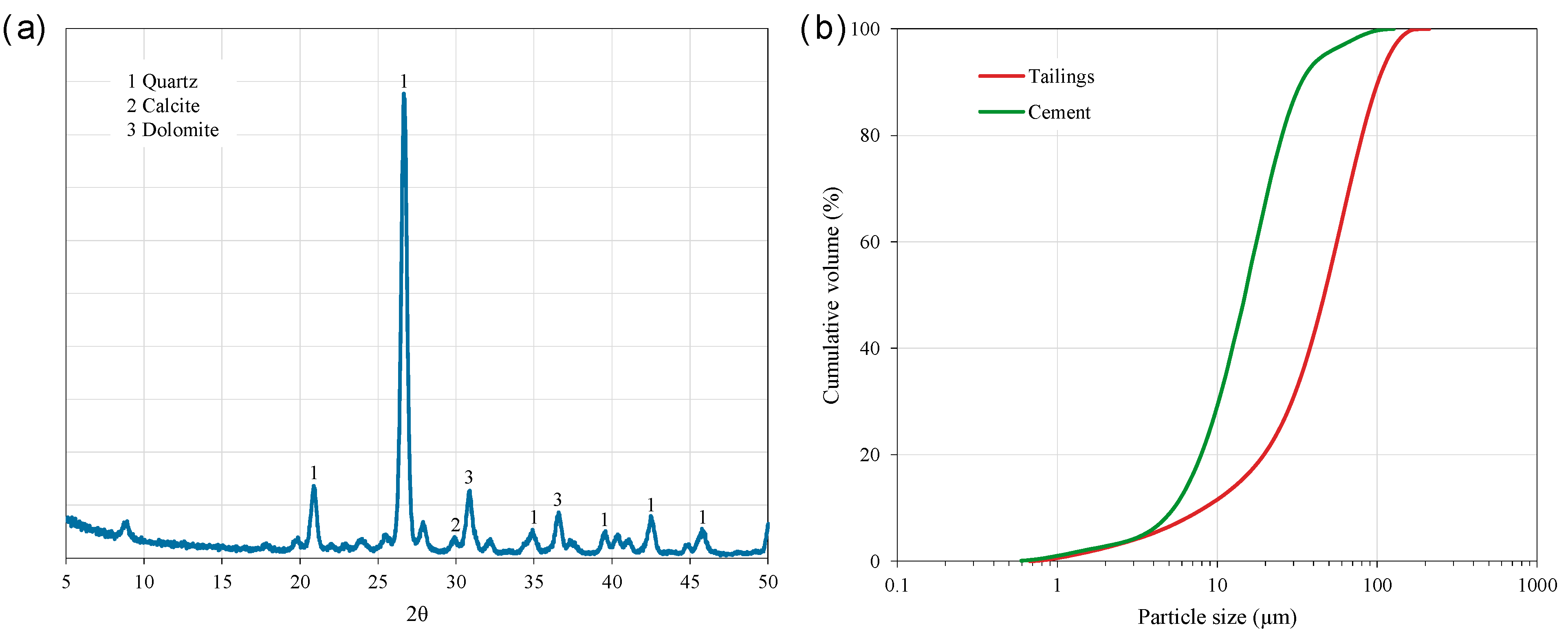

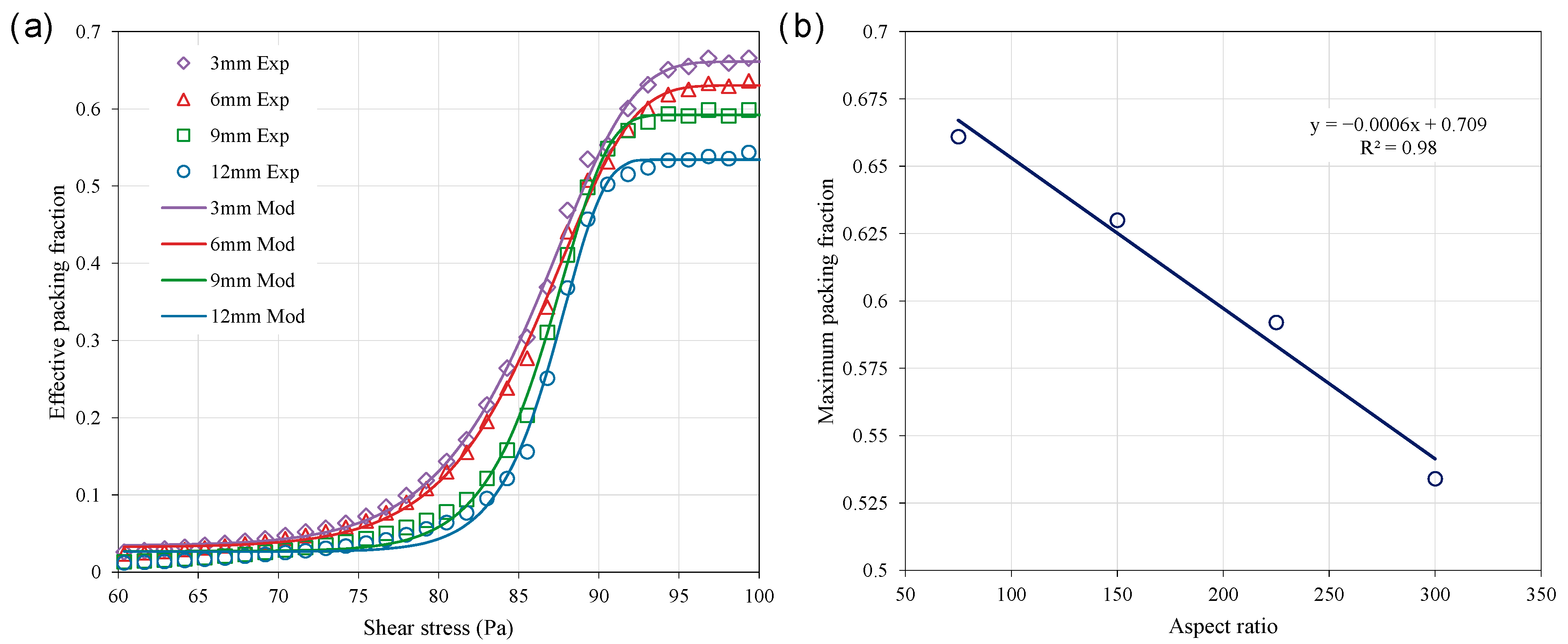
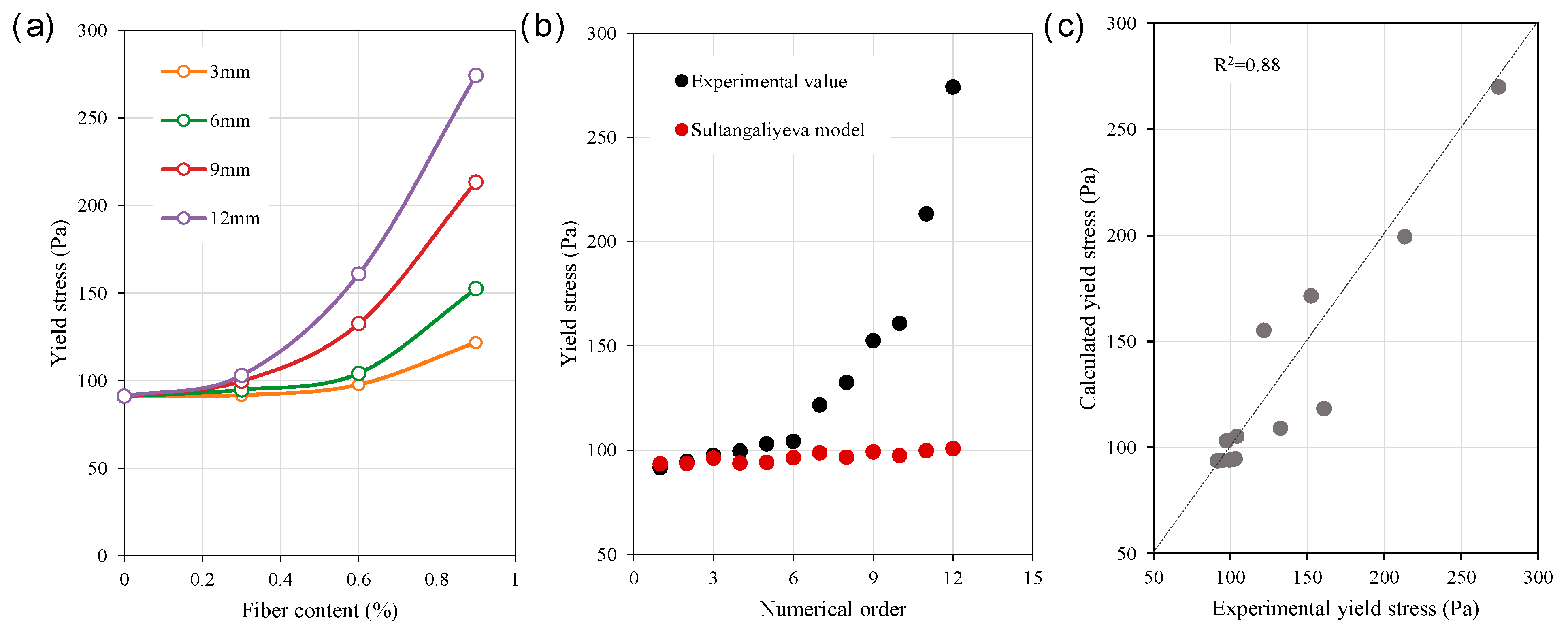
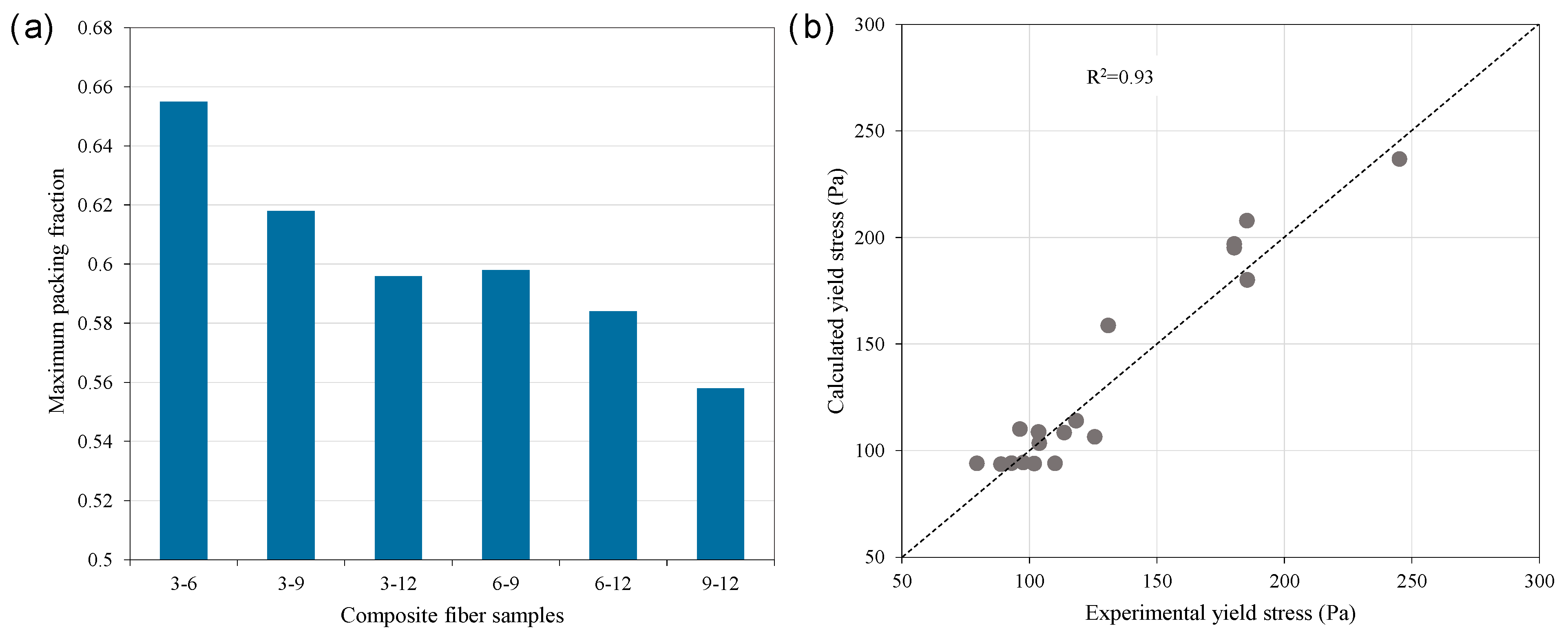
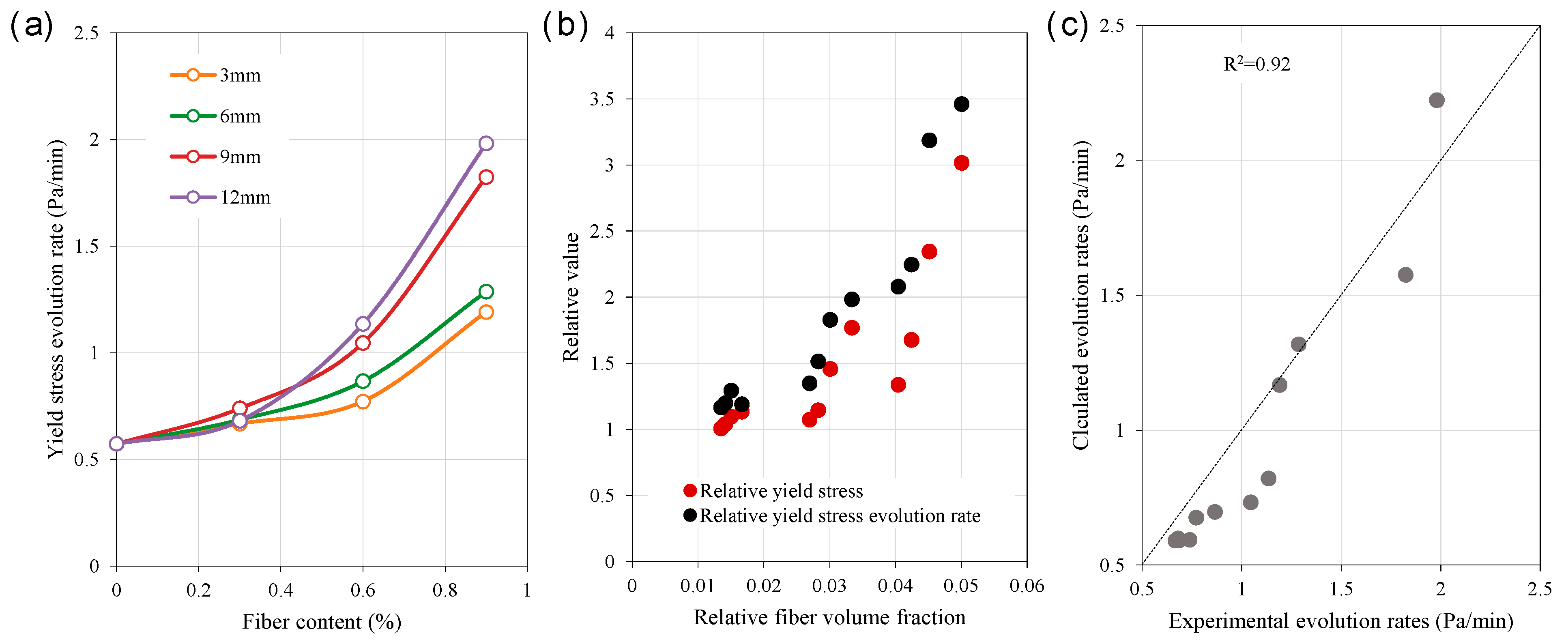
| Trial Mix | Solid Content (%) | Binder Dosage (%) | Fiber Content | Fiber Length (mm) | |
|---|---|---|---|---|---|
| Vol.% | Wt.% | ||||
| determination | 76 | 10 | 0 | 0 | 3, 6, 9, 12 |
| 0.08 | 0.027 | ||||
| 0.1 | 0.034 | ||||
| Yield stress measurement | 0 | 0 | |||
| 0.891 | 0.3 | ||||
| 1.782 | 0.6 | ||||
| 2.674 | 0.9 | ||||
| Model validation | 0.891 | 0.3 | |||
| 1.782 | 0.6 | ||||
| 2.674 | 0.9 | ||||
| Time-dependent yield stress | 0 | 0 | |||
| 0.891 | 0.3 | ||||
| 1.782 | 0.6 | ||||
| 2.674 | 0.9 | ||||
Disclaimer/Publisher’s Note: The statements, opinions and data contained in all publications are solely those of the individual author(s) and contributor(s) and not of MDPI and/or the editor(s). MDPI and/or the editor(s) disclaim responsibility for any injury to people or property resulting from any ideas, methods, instructions or products referred to in the content. |
© 2025 by the authors. Licensee MDPI, Basel, Switzerland. This article is an open access article distributed under the terms and conditions of the Creative Commons Attribution (CC BY) license (https://creativecommons.org/licenses/by/4.0/).
Share and Cite
Hu, S.; Qiu, J.; Zhang, Q.; Guo, Z.; Liu, C. Quantitative Analysis of Yield Stress and Its Evolution in Fiber-Reinforced Cemented Paste Backfill. Minerals 2025, 15, 81. https://doi.org/10.3390/min15010081
Hu S, Qiu J, Zhang Q, Guo Z, Liu C. Quantitative Analysis of Yield Stress and Its Evolution in Fiber-Reinforced Cemented Paste Backfill. Minerals. 2025; 15(1):81. https://doi.org/10.3390/min15010081
Chicago/Turabian StyleHu, Shili, Jingping Qiu, Qingsong Zhang, Zhenbang Guo, and Chen Liu. 2025. "Quantitative Analysis of Yield Stress and Its Evolution in Fiber-Reinforced Cemented Paste Backfill" Minerals 15, no. 1: 81. https://doi.org/10.3390/min15010081
APA StyleHu, S., Qiu, J., Zhang, Q., Guo, Z., & Liu, C. (2025). Quantitative Analysis of Yield Stress and Its Evolution in Fiber-Reinforced Cemented Paste Backfill. Minerals, 15(1), 81. https://doi.org/10.3390/min15010081








